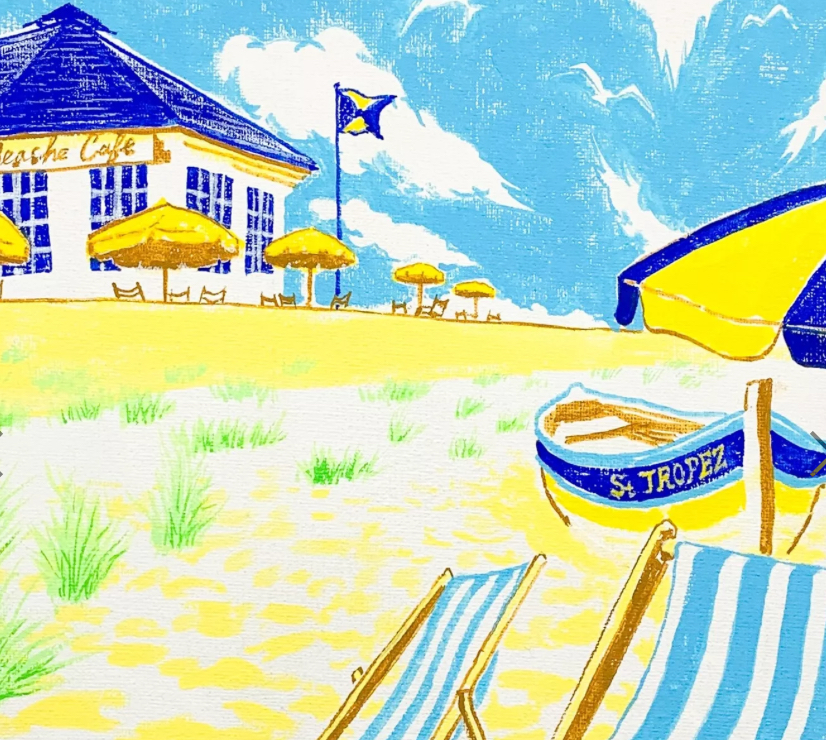A Meditation on Place, Presence, and Print
In Striped Beach Chair (2023), Hiroshi Nagasawa (ナガサワ ヒロシ) constructs a deceptively simple image—a beach chair, its fabric rendered in rhythmic color bands, positioned slightly askew against an indeterminate white ground. But what appears at first glance as an observational study of leisure quickly reveals itself to be an exercise in displacement, absence, and material tension.
Executed using acrylic printing, the piece belongs to Nagasawa’s later-phase investigation into functional objects as philosophical devices. In much of his recent work, everyday structures—chairs, ladders, frameworks—are recontextualized through minimal yet evocative interventions. They become sites for contemplation, rather than utility. Striped Beach Chair sits firmly in this tradition, inviting not rest but reflection.
Hiroshi Nagasawa: Sculptor of Thought and Light
Born in 1946, Nagasawa has long resisted categorization. Though trained in sculpture and spatial composition, his oeuvre spans installation, printmaking, architectural intervention, and object-based conceptualism. From his early “suspended works,” which literally levitated frames and surfaces using counterbalance and fine wire, to his poetic collaborations with architects and poets, he has continually sought to make visible the invisible forces that govern perception—gravity, absence, memory, space.
Based primarily in Japan but with a long-standing presence in Italy, particularly Milan, Nagasawa’s cross-cultural approach blends Eastern metaphysics with Western material experimentation. Striped Beach Chair, while formally modest, is layered with this hybrid intellectual DNA.
The Chair as Symbol, Surface, and Sculpture
The beach chair in Striped Beach Chair functions on multiple semiotic levels. As an object, it connotes relaxation, impermanence, and lightness. But in Nagasawa’s framing, it is also a proxy for the absent body, a stand-in for the viewer or imagined sitter.
The striped pattern—reminiscent of Mediterranean or Japanese coastlines—serves not only an aesthetic purpose but suggests time’s passage and visual rhythm. Each band of color becomes a measure, like the gradations on a metronome or the rungs on a ladder. Their arrangement evokes both order and entropy, as the printing process introduces slight tonal variations and bleed, refusing mechanical perfection.
The chair’s skewed perspective—tilted slightly off-axis—breaks the logic of frontal composition, suggesting motion or the trace of prior presence. There is no beach, no shadow, no horizon, just the chair in its isolated declaration. It floats, suspended in the plane, much like the bodies Nagasawa has suspended in sculptural wire frames throughout his career.
Acrylic Printing: The Mechanism of Stillness
The choice of acrylic printing is crucial here. Unlike traditional painting or silkscreen, acrylic print captures texture with tactile precision. Nagasawa uses this medium not just to reproduce an image but to inscribe a surface experience. The result is simultaneously glossy and flat, reflective and matte—creating a perceptual push-pull between the physicality of the chair and the illusory field around it.
The printing process allows the work to feel industrial yet intimate, machine-like in clarity but gestural in registration. This paradox mirrors Nagasawa’s wider interest in how objects occupy space—not as inert tools, but as agents of affect.
In this sense, Striped Beach Chair isn’t about a beach chair at all. It’s about how perception transforms context, and how reproduction—the print—can itself become original through intention.
Echoes of Arte Povera and Zen Koan
There’s a haunting sparsity to Striped Beach Chair that resonates with both Arte Povera (with whom Nagasawa had personal and professional intersections in 1970s Italy) and Zen philosophy. Like Pistoletto’s mirrors or Kounellis’ installations of wool and iron, Nagasawa’s work refuses traditional ornamentation in favor of presence, void, and implication.
At the same time, his chair poses a question in the form of an image—a visual koan. If no one sits in a chair, is it still a seat? If the stripes continue forever, do they become a field? What happens when a utilitarian object is rendered useless by being art?
These questions are not resolved, nor are they meant to be. Nagasawa’s gift is in holding them lightly—like air or time—offering them not as riddles but as invitations.
Spatial Politics and Solitude
There is also a subtle spatial politics at play. The chair is empty. The background is blank. There is no context. In 2023—a world riddled with burnout, hyperconnectivity, and environmental dislocation—what does it mean to offer a chair and no place to put it?
This void becomes an emotional proposition. The chair isn’t staged on a beach, but in a conceptual desert—an intentional loneliness that resists narrative or utopia. The stripes do not promise escape, but containment. We are alone with the object, and in doing so, alone with ourselves.
In a culture of maximalist digital imagery, this flat, quiet print is a profound act of resistance. It declines to entertain, choosing instead to dwell.
Situating the Work in Nagasawa’s Career
Striped Beach Chair echoes many of Nagasawa’s past projects in its thematic skeleton. His 1989 series of suspended frames suggested art as anti-object, a container for what could not be seen. His 2006 piece Chair for the Sky reimagined seating as scaffolding for the invisible. Even his more architectural projects—like La Casa Telematica—explored how domestic forms could resist functionality to provoke thought.
But this 2023 work feels more distilled. It is slowed down, reduced to gesture and surface. It suggests the artist, in his seventh decade of work, is not simplifying out of fatigue, but from clarity. The chair doesn’t shout. It waits.
And in that waiting, it watches us.
Legacy and the Imprint of the Present
Nagasawa’s legacy is difficult to summarize because it resists market systems and stylistic epochs. He is a sculptor who rarely sculpts in bronze. A printer who uses the machine like a brush. A thinker whose works feel like pauses, not exclamations.
But Striped Beach Chair serves as a powerful late-career statement. It suggests that stillness is not stasis, and that the most radical act may be to suggest, rather than declare. It teaches that art can whisper and still resound.
As climate anxiety, digital fatigue, and social fragmentation define the 2020s, Nagasawa gives us not resolution but a place to sit and consider—even if only in the imagination.
To Sit is to See Differently
At its surface, Striped Beach Chair is modest: a chair, some stripes, a white field. But its ambitions are metaphysical. It asks us to re-learn the object. To see the common as uncommon. To question our seated assumptions.
In a world obsessed with movement, Nagasawa gives us a print of a chair that invites no one to sit, and in doing so, offers a chance to stand still—and, perhaps, begin again.
No comments yet.








